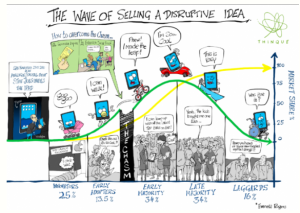Credit: theinnovationandstrategyblog.com
Over the past few years I’ve been hearing quite a bit from certain corners of the space community, including certain corners of NASA, about the need for disruptive innovation in the U.S. space program.
I’ll offer just a few examples.
On a Web site where he peddles himself as a speaker-for-hire, Peter Diamandis – would-be asteroid miner, co-founder of Singularity University and head of the X Prize Foundation — offers talks on the topic of “exponential technologies causing disruptive innovation…. He provides key insights on how human society has transformed from “Local & Linear” to one that is now “Global & Exponential,” and how this change is accelerating disruptive stress or disruptive opportunity depending on the company’s point of view.”
NASA Tech Briefs offers a link to a webinar on “designing disruptive technology for a sustainable future.”
Testifying at a December 2012 hearing on the future of NASA, Thomas Zurbuchen, Professor for Space Science and Aerospace Engineering and Associate Dean for Entrepreneurial Programs at the University of Michigan, made the case for disruptive innovation at NASA. “Disruptive programs overturn old paradigms, create new markets and engender new value systems.”
Now Harvard history professor Jill Lepore offers an excellent critique of the ideology of disruptive innovation, revealing how it is the centuries-old dogma of progress dressed up in 21st century clothes. In The June 23 issue of The New Yorker – “The disruption machine: what the gospel of innovation gets wrong” – Lepore dissects the idea of disruptive innovation, as propagated by Clayton Christensen in his 1997 book, The Innovator’s Dilemma, 1997), Josh Linkner (The Road to Reinvention: How to Drive Disruption and Accelerate Transformation, 2011], and others. She writes: “The idea of innovation is the idea of progress stripped of the aspirations of the Enlightenment, scrubbed clean of the horrors of the 20th century, and relieved of its critics. Disruptive innovation goes further, holding out the hope of salvation against the very damnation it describes: disrupt, and you will be saved.”
Well said.
I’ve been studying the history of the idea of progress since the 1990s. In a paper published in 2007, I wrote about the idea of progress as it’s embedded in the ideology of space flight:
“Christopher Lasch [The True and Only Heaven: Progress and Its Critics, 1991] contrasted the pre-modern, Christian idea of progress – ‘the promise of a secular utopia that would bring history to a happy ending’ – with the modern idea – ‘the promise of steady improvement with no foreseeable ending.’ While J.B. Bury [The Idea of Progress, 1920] identified progress as an idea originating in the modern era, Robert Nisbet [History of the Idea of Progress, 1980, 1994] traced its roots to ancient Greek and Roman philosophy, and he documented how it evolved to take on the qualities of destiny and ‘historical necessity.’ This modern idea of necessary and inevitable forward movement is deeply embedded in the cultural narrative of U.S. space flight.
The idea of progress became the dominant idea in Western thinking in the period 1850-1900, according to Nisbet, serving as ‘the developmental context for other [key] ideas’ such as freedom. Nisbet credited 19th century natural philosopher Herbert Spencer with melding the ideas of progress and freedom, in declarations of ‘the rights of life and personal liberty,’ ‘the right to use the Earth,’ ‘the right of property,’ and ‘the right to ignore the state.’ Spencer’s classical liberal thinking is noticeable in the rhetoric of space advocacy.
From the 17th through the 20th century, as Walter McDougall wrote […the Heavens and the Earth: A Political History of the Space Age, 1985, 1997], the Western scientific worldview…’elevated technological progress…to the level of moral imperative.’ Science and technology became the means of American progress, and conquest and exploitation became the morally imperative method.”
Back to Lepore’s critique…. Citing Linkner, she sums up the ideology of disruptive innovation this way: “Forget rules, obligations, your conscience, loyalty, a sense of the commonweal. If you start a business ands it succeeds…sell it and take the cash. Don’t look back. Never pause. Disrupt or be disrupted.”
How depressing.
As always, I’m not asking my colleagues in the space community not to have beliefs or embrace ideologies. All I’m asking is that we all acknowledge and understand the belief systems we do have and the ways in which our beliefs motivate our actions.
If you don’t like my take on Lepore’s critique, you can read another one in Inc. magazine.

December 31, 2015 at 3:06 pm
[…] approach to the sociotechnical ‘disruptions’ sought by Silicon Valley entrepreneurs.” (See my post of June 25, 2014, on Jill Lepore’s critique of the idea of “disruptive […]